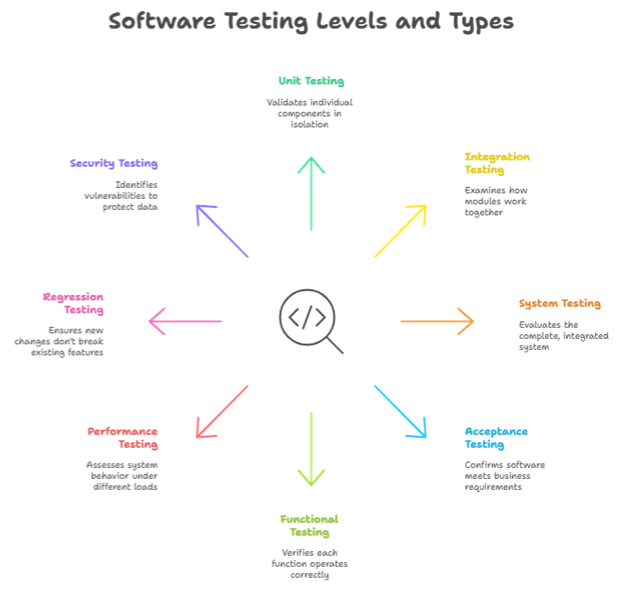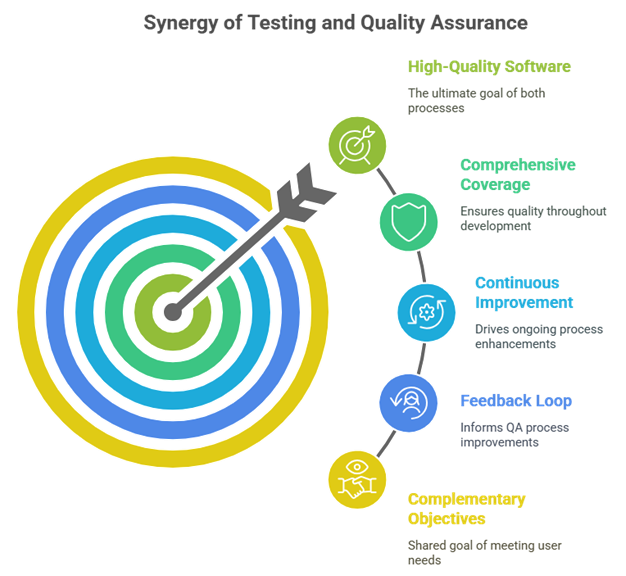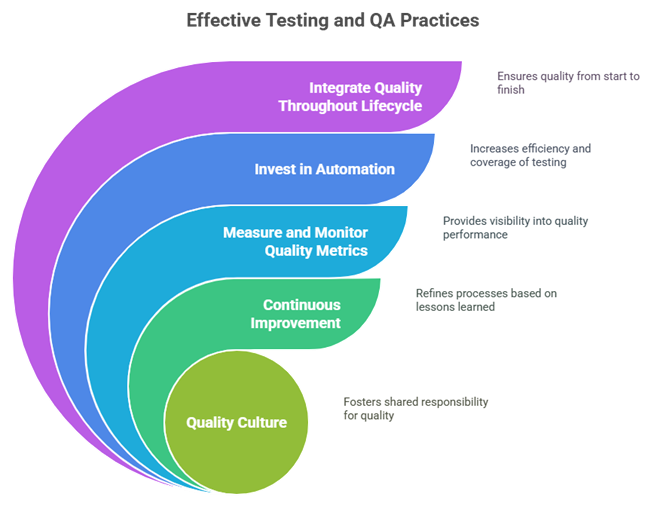
In today’s rapidly evolving digital landscape, delivering high-quality software has become more crucial than ever. Organizations worldwide recognize that the success of their digital products hinges not just on innovative features, but on reliability, security, and user satisfaction. This is where software testing and quality assurance come into play – two distinct yet complementary approaches that ensure software meets the highest standards before reaching end-users.
At ideyaLabs, we understand that navigating the complex world of software quality can be challenging. Many professionals, especially those new to the tech industry, often use the terms “software testing” and “quality assurance” interchangeably. However, these represent different methodologies with unique objectives, processes, and outcomes. Understanding these differences is essential for implementing effective quality strategies in your software development lifecycle.
In this comprehensive guide, we’ll explore the fundamental distinctions between software testing and quality assurance, their respective roles in software development, and how they work together to deliver exceptional digital products. Whether you’re a project manager, developer, or business stakeholder, this knowledge will help you make informed decisions about your quality management approach.
Understanding Software Testing: The Detective Work of Software Development
Software testing is akin to detective work – a methodical investigation process designed to uncover defects, bugs, and inconsistencies in software applications. It involves executing a program or system with the specific intent of finding errors that could impact functionality, performance, or user experience.
The International Software Testing Qualifications Board (ISTQB) defines software testing as a process of verifying that software applications or programs meet specified requirements and are free from defects. This technical process typically occurs after the development phase and before the software is released to end-users.
Software testing is fundamentally product-oriented and reactive in nature. Testers examine the software after it has been developed, looking for issues that may have been introduced during the coding process. The primary focus is on the product rather than the development process itself.
The Multi-Faceted Nature of Software Testing

Software testing encompasses various levels and types of testing, each serving a specific purpose in the quality verification process:
Unit Testing forms the foundation of the testing pyramid. Developers conduct this testing to validate individual components or functions of the software in isolation. By ensuring each unit performs as expected, developers can catch issues early in the development cycle when they’re the least expensive to fix. Unit tests are typically automated and run frequently during development.
Integration Testing takes a step further by examining how different modules or services work together. This level of testing is crucial in today’s microservices architecture, where applications are built as a collection of loosely coupled services. Integration testing verifies that these components communicate correctly and that data flows properly between them.
System Testing evaluates the complete, integrated software system to ensure it meets specified requirements. This comprehensive testing approach examines the software from end to end, validating both functional and non-functional aspects such as performance, security, and usability.
Acceptance Testing is the final verification before release, confirming that the software satisfies business requirements and is ready for delivery. User acceptance testing (UAT) involves actual users testing the software in real-world scenarios to ensure it meets their needs and expectations.
Beyond these levels, specialized types of testing address specific quality aspects:
Functional Testing verifies that each function of the software operates according to requirements. Testers execute test cases based on functional specifications, checking that the software behaves as expected under various conditions.
Performance Testing evaluates how the system performs under different workloads. This includes stress testing to determine breaking points, load testing to assess behavior under expected user loads, and scalability testing to verify the system can handle growing demands.
Regression Testing ensures that new code changes don’t adversely affect existing functionality. This type of testing is particularly important in agile environments where frequent iterations could inadvertently introduce bugs in previously working features.
Security Testing identifies vulnerabilities in software that could be exploited by malicious users. This critical testing helps protect sensitive data and ensures the system can withstand various types of attacks.
The Tangible Benefits of Robust Software Testing
Implementing comprehensive software testing yields numerous advantages for organizations:
Enhanced product quality stands as the most obvious benefit. By systematically identifying and eliminating defects, testing ensures that the final product meets quality standards and user expectations. This leads to higher customer satisfaction and loyalty, as users encounter fewer issues when using the software.
Early defect detection represents another significant advantage. Finding and fixing bugs during the testing phase is considerably less expensive than addressing them after release. Industry studies suggest that the cost of fixing a bug increases exponentially the later it’s discovered in the development of a lifecycle. Testing helps catch these issues when they’re most economical to resolve.
Cost savings extend beyond just bug fixes. By preventing major issues from reaching production, testing helps avoid the substantial costs associated with emergency patches, customer support escalations, and potential reputation damage. The investment in testing typically pays for itself many times over through reduced maintenance costs.
Improved user experience results from thorough testing. When software functions reliably and intuitively, users can accomplish their tasks without frustration. This positive experience builds trust in the product and the organization behind it, leading to increased adoption and retention.
The Limitations of Software Testing
Despite its critical importance, software testing has inherent limitations that organizations should recognize:
Time constraints often present challenges. Comprehensive testing can be time-consuming, potentially delaying release schedules in fast-paced development environments. This creates tension between quality assurance and time-to-market pressures.
Scope limitations exist because testing can only verify the software being tested, not the entire ecosystem in which it operates. This can lead to issues when the software interacts with other systems or under conditions that weren’t anticipated during testing.
Testing is based on assumptions about how the software will be used and what conditions it will encounter. If these assumptions are incorrect, the testing may miss critical scenarios, leading to unexpected failures in production.
Complexity challenges arise as modern software systems become increasingly sophisticated. The number of possible test cases grows exponentially with system complexity, making it impossible to test every potential scenario. This reality means that even well-tested software may contain undiscovered bugs.
Quality Assurance: The Proactive Guardian of Software Excellence
While software testing focuses on finding defects in the product, quality assurance (QA) takes a broader, more proactive approach. QA is a systematic process that ensures a company’s products meet established quality standards throughout the entire development lifecycle.
Quality assurance is fundamentally process-oriented rather than product-oriented. It focuses on preventing defects by improving development processes, rather than just detecting them after they occur. This preventive approach begins during the planning stages and continues through development, testing, and deployment.
The ISTQB defines quality assurance as “activities focused on providing confidence that quality requirements will be fulfilled.” These activities involve examining and improving the processes that lead to the result, rather than just examining the result itself.
The Comprehensive Scope of Quality Assurance
Quality assurance encompasses a wide range of activities designed to prevent quality issues before they arise:
Process Definition and Improvement forms the foundation of QA. This involves establishing standardized development processes, workflows, and methodologies that incorporate best practices for quality. QA professionals continuously analyze these processes to identify inefficiencies or quality risks, then implement improvements to address them.
Requirements Management ensures that project requirements are well-defined, complete, and aligned with stakeholder expectations. QA teams verify that requirements are clear, testable, and traceable throughout the development lifecycle, preventing misunderstandings that could lead to defects.
Design Reviews evaluate software architecture and design before implementation begins. These reviews identify potential quality issues early, when they’re easiest to address. By scrutinizing design decisions against quality standards and best practices, QA helps prevent architectural flaws that could compromise the entire system.
Code Reviews examine source code to identify bugs, security vulnerabilities, and adherence to coding standards. This peer review process catches issues that might be missed during testing and helps maintain code quality across the development team.
Documentation Management ensures that all project documentation is accurate, complete, and up to date. This includes requirements specifications, design documents, test plans, and user manuals. Proper documentation supports quality by providing clear guidance for development and testing activities.
Standards Compliance verifies that development processes and deliverables adhere to relevant industry standards and regulations. This is particularly important in regulated industries like healthcare, finance, and aviation, where compliance failures can have serious consequences.
Training and Mentoring helps team members develop the skills and knowledge needed to produce high-quality work. QA professionals often provide guidance on best practices, tools, and techniques that support quality objectives.
The Strategic Advantages of Quality Assurance
Implementing robust quality assurance practices offers several strategic benefits for organizations:
Improved reliability results from systematic quality processes that prevent defects throughout the development of lifecycles. By addressing potential issues at their source, QA helps create software that performs consistently and predictably under various conditions.
Increased customer satisfaction stems from delivering products that meet or exceed expectations. When the software works as intended and provides positive user experience, customers are more likely to remain loyal and recommend the product to others.
Defect prevention represents a significant cost advantage. By focusing on preventing defects rather than just finding and fixing them, QA reduces the overall cost of quality. Industry research consistently shows that preventing defects is far less expensive than correcting them after they’ve been introduced.
Process improvement drives ongoing efficiency gains. As QA identifies and addresses process weaknesses, development becomes more streamlined and predictable. This leads to shorter development cycles, more accurate estimates, and better resource utilization.
Risk mitigation is another key benefit. By identifying potential quality issues early and implementing preventive measures, QA helps organizations avoid costly failures, security breaches, and compliance violations that could damage their reputation and bottom line.
Key Differences Between Software Testing and Quality Assurance

Understanding the distinctions between software testing and quality assurance helps organizations implement both approaches effectively:
Focus and Approach
Software testing focuses specifically on identifying defects in the software product. It’s a technical activity that involves executing the software under controlled conditions to evaluate its behavior and identify issues. Testing is inherently reactive – it finds problems that already exist in the code.
Quality assurance, by contrast, focuses on improving the processes used to create the software. It’s a managerial activity that involves defining standards, implementing best practices, and monitoring development processes to prevent defects from being introduced. QA is inherently proactive – it aims to prevent problems before they occur.
Timing and Scope
Software testing typically occurs after code has been written. It’s a phase-specific activity that takes place primarily during the testing phase of the development lifecycle, though modern approaches like test-driven development (TDD) may integrate testing earlier.
Quality assurance spans the entire development life cycle, from initial planning through deployment and maintenance. It’s a continuous process that influences every phase of development, not just a specific stage.
Responsibility and Skills
Software testing is typically performed by dedicated testers who have specialized skills in test design, execution, and defect reporting. These professionals focus on finding and documenting issues in the software.
Quality assurance is often managed by QA engineers or quality managers who have broader knowledge of development processes, methodologies, and standards. These professionals focus on process improvement and defect prevention.
Cost and Investment
Software testing generally requires a higher investment in terms of time and resources for defective detection and fixing. The cost increases significantly when defects are found late in the development cycle or after release.
Quality assurance typically involves a lower long-term cost through defect prevention. While establishing QA processes requires initial investment, the return comes through reduced rework and maintenance costs.
Team Structure
Software testing often involves dedicated testing teams working collaboratively but separately from development teams. This separation provides an independent perspective on software quality.
Quality assurance may involve QA engineers working independently across multiple teams to establish and monitor quality processes. QA professionals often serve as consultants and facilitators rather than direct executors of quality activities.
The Synergy Between Testing and Quality Assurance

While software testing and quality assurance have distinct roles, they work most effectively when implemented together as part of a comprehensive quality strategy:
Complementary Objectives
Both approaches share the goal of delivering high-quality software that meets user’s needs and expectations. Testing focuses on verifying that the product meets requirements, while QA ensures that the processes used to create the product are effective and efficient.
Feedback Loop
Testing provides valuable feedback that informs QA process improvements. When testing identifies recurring defect patterns, QA can analyze root causes and implement process changes to prevent similar issues in the future.
Continuous Improvement
The combination of testing and QA creates a powerful continuous improvement cycle. Testing identifies immediate issues that need to be fixed, while QA addresses systemic problems that could cause future defects.
Comprehensive Coverage
Together, testing and QA provide comprehensive quality coverage throughout the development lifecycle. QA establishes preventive measures during planning and development, while testing provides verification before release.
Balanced Approach
Organizations benefit from balancing reactive testing with proactive QA. This combined approach addresses both immediate quality concerns and long-term process improvements.
Choosing the Right Approach for Your Organization
The optimal quality strategy depends on your organization’s specific needs, constraints, and objectives:
When to Emphasize Software Testing
Prioritize software testing when your primary concern is ensuring that the current product is free of bugs and defects. This approach is particularly valuable when:
- You need to verify that the software meets specific requirements and expectations
- You’re preparing for an imminent release and need to identify any critical issues
- You’re working with legacy code that wasn’t developed under strict quality processes
- You need to validate specific functionality, performance, or security aspects
When to Emphasize Quality Assurance
Prioritize quality assurance when your focus is on long-term quality improvement and defect prevention. This approach is especially beneficial when:
- You’re establishing or optimizing your development processes
- You want to prevent defects rather than just find and fix them
- You need to ensure adherence to industry standards or regulatory requirements
- You’re experiencing recurring quality issues that indicate process problems
Finding the Right Balance
Most organizations benefit from implementing both approaches in a balanced quality strategy:
Start by assessing your current quality challenges and objectives. Identify whether you’re primarily dealing with product issues (indicating a need for more testing) or process issues (suggesting a focus on QA).
Consider your development methodology. Agile and DevOps approaches typically integrate testing and QA throughout the development cycle, while waterfall methods may separate these activities into distinct phases.
Evaluate your resource constraints. If you have limited resources, focus on the approach that addresses your most pressing quality concerns first, then gradually expand your quality program as resources allow.
Implement continuous improvement by regularly reviewing your quality metrics and adjusting your balance of testing and QA activities based on changing needs and results.
The Evolution of Testing and Quality Assurance in Modern Development
The landscape of software testing and quality assurance continues to evolve with changing development practices and technologies:
Shift-Left Testing
Modern development teams are increasingly “shifting left” – moving testing earlier in the development process. This approach aligns with QA’s preventive philosophy by identifying issues when they’re easiest and least expensive to fix.
Automation and Continuous Testing
Automation has transformed both testing and QA by enabling continuous testing throughout the development pipeline. Automated tests run with each code change, providing immediate feedback to developers and reducing the time between introducing a defect and discovering it.
DevOps Integration
In DevOps environments, testing and QA are integrated into a continuous delivery pipeline. This integration ensures that quality checks occur automatically with each building and deployment, maintaining quality even with rapid release cycles.
AI and Machine Learning
Emerging AI and machine learning technologies are enhancing both testing and QA. These technologies can predict potential defect areas, optimize test coverage, and identify patterns that human analysts might miss.
Quality Engineering
The concept of quality engineering represents a holistic approach that combines elements of both testing and QA. Quality engineers focus on building quality into products from the beginning rather than testing them later.
Implementing Effective Testing and QA Practices

To maximize the benefits of both software testing and quality assurance, consider these implementation strategies:
Establish Clear Quality Objectives
Define specific, measurable quality objectives that align with your business goals. These objectives should guide both your testing activities and QA processes, ensuring that quality efforts support organizational priorities.
Integrate Quality Throughout the Lifecycle
Incorporate quality considerations from the earliest stages of development. Requirements should be reviewed for testability, designs should be evaluated for quality risks, and code should be continuously tested as it’s developed.
Invest in Automation
Automate repetitive testing tasks to increase efficiency and coverage. Automated tests can run frequently and consistently, freeing human testers to focus on more complex scenarios that require critical thinking.
Measure and Monitor Quality Metrics
Establish key quality metrics that provide visibility into both product quality (defect density, test coverage) and process quality (defect escape rate, process compliance). Regularly review these metrics to identify trends and improvement opportunities.
Foster a Quality Culture
Build a culture where quality is everyone’s responsibility, not just the domain of testers or QA specialists. Encourage developers to write testable code, conduct peer reviews, and participate in quality improvement initiatives.
Continuously Improve
Implement regular retrospectives to evaluate your quality processes and identify improvement opportunities. Use lessons learned from each project to refine your approach to both testing and QA.
Conclusion: The Power of a Unified Quality Approach
Software testing and quality assurance represent different but complementary approaches to achieving software excellence. Testing focuses on finding and fixing defects in the product, while QA works to prevent defects by improving development processes. Both are essential components of a comprehensive quality strategy.
At ideyaLabs, we believe that the most successful organizations integrate both approaches, creating a unified quality framework that addresses immediate product concerns while building long-term quality capabilities. By understanding the distinct roles and synergies between testing and QA, you can develop a balanced quality strategy that delivers reliable, high-performing software that delights your users.
In today’s competitive digital landscape, quality isn’t just a technical concern, it’s a business imperative. Organizations that excel at both testing and quality assurance gain a significant competitive advantage through improved customer satisfaction, reduced costs, and faster time to market.
Whether you’re just beginning your quality journey or looking to optimize your existing practices, remember that effective quality management is an ongoing process of learning and improvement. By continuously refining your approach to both testing and QA, you can build a quality capability that supports your organization’s success now and in the future.